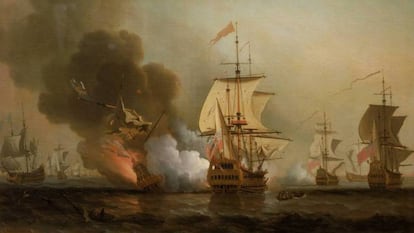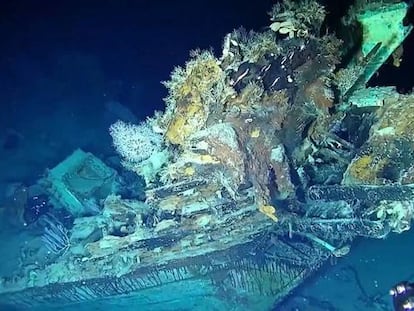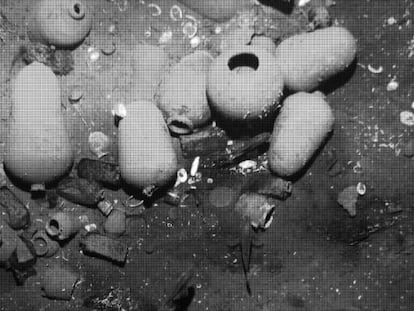Colombia aims to salvage the sunken treasure of the ‘San José’, but experts remain skeptical
President Gustavo Petro announced a public-private partnership to recover precious artifacts from a Spanish galleon that sank in the Caribbean Sea in 1708

The alluring enigma surrounding the San José, a Spanish galleon that met its demise in 1708 at the hands of English privateers near the Colombian Caribbean coast, has taken an intriguing turn. After years of legal battles and legends of untold riches, Colombian president Gustavo Petro has proposed a public-private team to undertake a mission to salvage a staggering $20 billion deep-sea treasure despite opposition from scientific and cultural groups advocating for the preservation of the archaeological site.
The Colombian authorities are the only ones who know the exact coordinates of the wreck. In recent years, a few underwater images have been released, revealing vases, coins, cannons, and parts of the San José's anchor. Adding to the excitement, the government announced in June 2022 the discovery of gold ingots, Chinese tableware, and two new sunken vessels in the same area.
Culture Minister Juan David Correa said the Navy, the Colombian Institute of Anthropology and History and other institutions have agreed to conduct an initial salvage effort to see how the archaeological artifacts will hold up. “There won’t be some massive extraction of gold and silver. We need to see the material and how it changes when we bring it up from depths that are near impossible to reach. We have to figure out a viable plan.”
Correa told The New York Times that project bidding will commence in early 2024 and will take about three years to deliver results. A museum and an archaeological study laboratory will be built in the Colombian city of Cartagena, on the Caribbean coast. To set expectations for the ambitious endeavor, Correa said, “We need to change our mindset and realize that it’s not just a 19th-century treasure. It’s an archaeological heritage that holds immense cultural value for Colombia.”

However, much of the scientific community strongly advises against any intervention at the site, citing the UNESCO Convention on the Protection of Underwater Cultural Heritage. “The Ministry of Culture’s premise is not aligned with current archaeological positions,” said historian and anthropologist Ricardo Borrero. “While it’s good they acknowledged that the shipwreck isn’t a treasure, the consensus is to maintain it in its current state, where it has lain for centuries in harmony with its surroundings.”
According to Borrero, images indicate that there is plentiful life in the area, which contradicts the initial assumptions. ”Deep-sea fish and algae form the foundation of the food chain in this environment. Any human intervention poses a threat to both nature and culture.” This debate originated in the 1980s, during the presidency of conservative leader Belisario Betancur, when some people said the San José's treasure could help pay off the country’s foreign debt. In 2001, the Colombian Congress voted against joining the UNESCO convention due to pressure from treasure hunters who argued that signing the agreement would put the country’s sovereignty at risk.
Contractual disagreements with European firms hired by Colombia to salvage the wreck and a tense diplomatic standoff with Spain further delayed the project. A vague law passed in 2013 during the Juan Manuel Santos (2010-2018) administration enabled private companies to freely explore and exploit the country’s underwater heritage. These companies have been in the hunt for sunken treasure ever since.
According to Mariano Aznar, a professor of international law at Jaume I University in Valencia (Spain), Colombia is still obligated to protect and cooperate in the preservation of Spain’s cultural heritage despite its failure to sign the United Nations Law of the Sea Treaty in 1982. Spain’s position is that the San José is a Spanish vessel in which 550 of its sailors perished, whereas Colombia is mostly focused on the ship’s potential commercial value.
Some say President Petro is being pressured by Roger Dooley, a 75-year-old American treasure hunter associated with the Swiss company Maritime Archeology Consultants (MAC), which has a controversial reputation among European archaeologists. Filipe Castro, a renowned expert in Iberian naval architecture and a professor at the University of Coimbra (Portugal), is one of the critics. “The warships of the late 17th century were highly complex and sophisticated machines. It feels like a crime to me to destroy them just to salvage a few coins..”
Castro doubts that the wreck can be salvaged in the three years announced by the Colombian government. “Only an unprofessional person or company would dare to claim that they can excavate a wreck at these depths in such a short time.” He also expressed concern about Colombia’s ability to properly preserve the salvaged heritage. Ricardo Borrero points to the poor condition of numerous colonial-era anchors and other artifacts decaying in Cartagena’s Naval Museum and other facilities.
Castro acknowledges the concerns regarding the availability of sustainable technological and scientific resources, and underscored the reservations about the potential involvement of companies like Maritime Archeology Consultants. “Treasure hunters typically make extravagant promises of vast riches to uninformed politicians. However, if the basic requirements of an archaeology project are met, Colombia’s expenses will far exceed the value of the promised treasure.”
Of the 55 wrecked Iberian vessels from the 17th century that have been located, scholars have only managed to complete the ideation, construction and design process in seven cases. The rest have been looted or completely ruined due to ill-conceived salvage efforts. Borrero says the San José is especially significant because it represents a crucial link between multipurpose galleons with large cargo holds and artillery, and ships specifically designed for warfare.
“Most importantly, we must stop talking about treasure,” said Mariano Aznar. “It’s a cultural heritage we share with other places like Manila, Asia, Bolivia and Mexico.” Its main value lies in its cultural significance and the insight it offers about the shared history of different peoples. What was the state of global trade at the time? What was daily life like on these ships? What else can we learn about those naval battles? Social scientists believe these questions can be answered without salvaging the ships.
The English warship Mary Rose (1545) and the Swedish Vasa (1626) offer valuable insights for this story. Experts point to the high cost of conserving raised vessels and the structural impacts to the wrecks. “The priority,” said Ricardo Borrero, “is to find out why Colombian authorities are intent on salvaging it, and then explore alternatives for gathering information without compromising the San José and its surroundings.”
Three centuries have passed since the San José went down, yet its precious heritage and watery resting place remains a battleground of conflicting political, economic and cultural ideologies.
Sign up for our weekly newsletter to get more English-language news coverage from EL PAÍS USA Edition
Tu suscripción se está usando en otro dispositivo
¿Quieres añadir otro usuario a tu suscripción?
Si continúas leyendo en este dispositivo, no se podrá leer en el otro.
FlechaTu suscripción se está usando en otro dispositivo y solo puedes acceder a EL PAÍS desde un dispositivo a la vez.
Si quieres compartir tu cuenta, cambia tu suscripción a la modalidad Premium, así podrás añadir otro usuario. Cada uno accederá con su propia cuenta de email, lo que os permitirá personalizar vuestra experiencia en EL PAÍS.
¿Tienes una suscripción de empresa? Accede aquí para contratar más cuentas.
En el caso de no saber quién está usando tu cuenta, te recomendamos cambiar tu contraseña aquí.
Si decides continuar compartiendo tu cuenta, este mensaje se mostrará en tu dispositivo y en el de la otra persona que está usando tu cuenta de forma indefinida, afectando a tu experiencia de lectura. Puedes consultar aquí los términos y condiciones de la suscripción digital.
More information
Archived In
Últimas noticias
Welcome to the post-religion era: The idea of Christianity as the absolute truth has become obsolete
‘I thought you would like it’: The risky sexual practice popularized by TV shows and TikTok
The digitalization of tourism: ‘They promise experiences and gave us the worst possible one’
Mexican peso defies uncertainty with forecasts of a new period of stability in 2026
Most viewed
- Sinaloa Cartel war is taking its toll on Los Chapitos
- Reinhard Genzel, Nobel laureate in physics: ‘One-minute videos will never give you the truth’
- Oona Chaplin: ‘I told James Cameron that I was living in a treehouse and starting a permaculture project with a friend’
- Why the price of coffee has skyrocketed: from Brazilian plantations to specialty coffee houses
- Silver prices are going crazy: This is what’s fueling the rally











































